


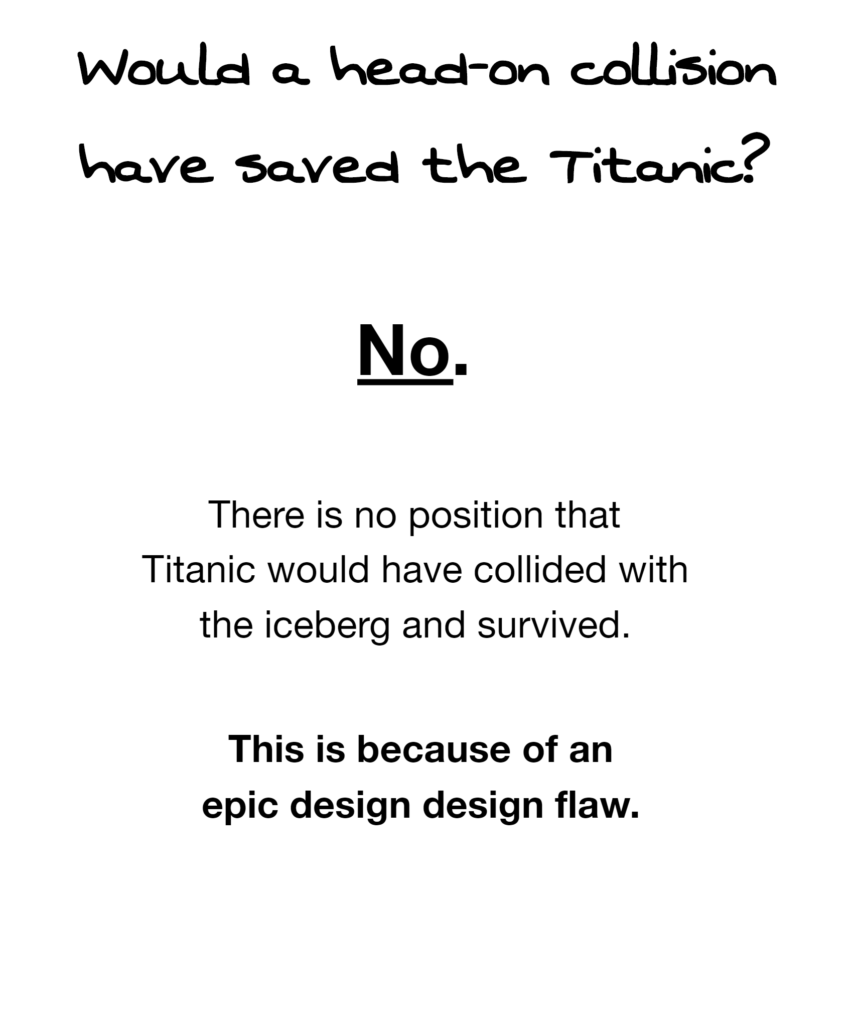

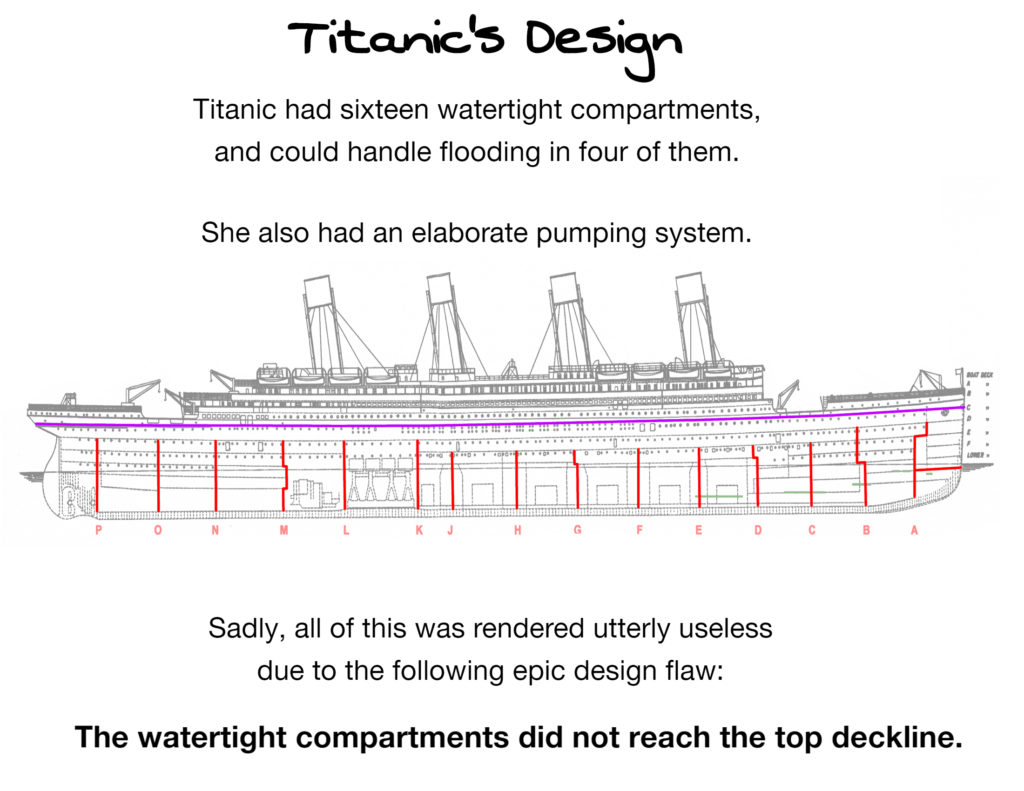
The red lines are the height of the watertight compartments, and the purple line is the height of the top deck.
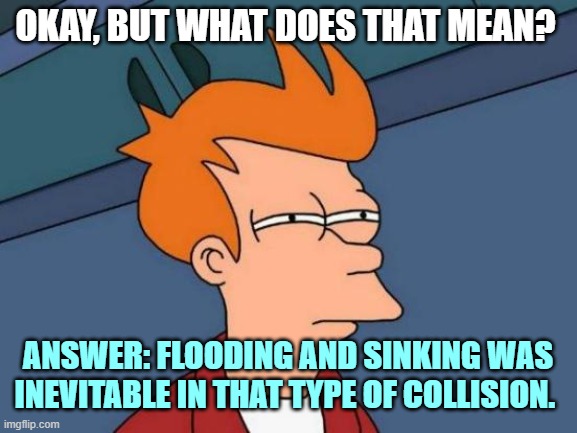
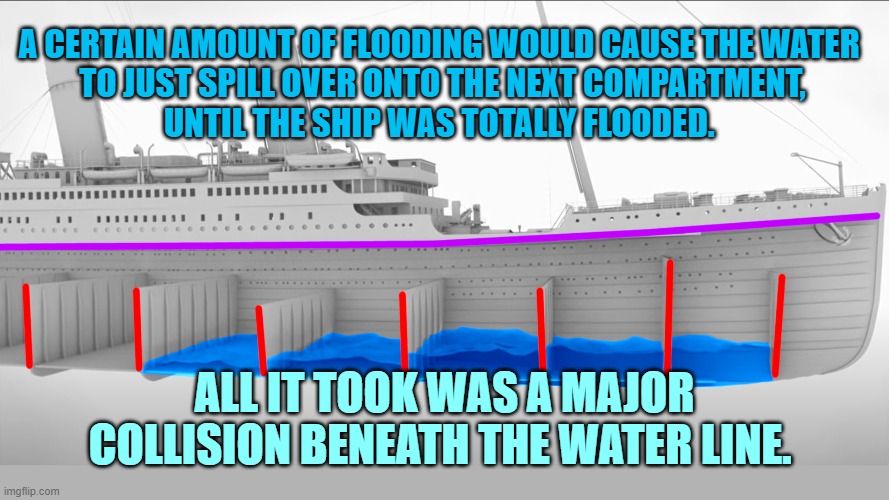
I want to thank Nova for their documentary on “Why Ships Sink,” which gave this amazing animation to display the seriousness of the Titanic wreck. If you’d like to watch it yourself, there’s a YouTube video of it: https://www.youtube.com/watch?v=QzVLfwjWSW8
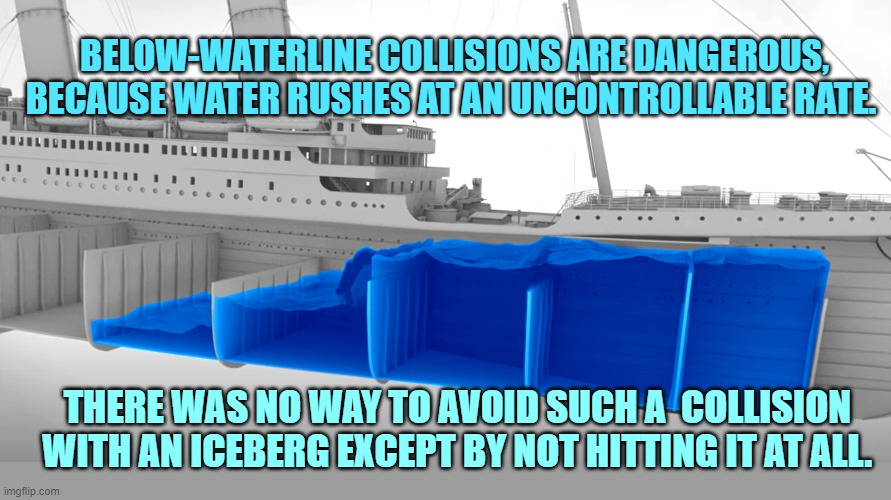
There is no amount of pumping that can keep the ocean out of a ship with a significant hole beneath the water line.
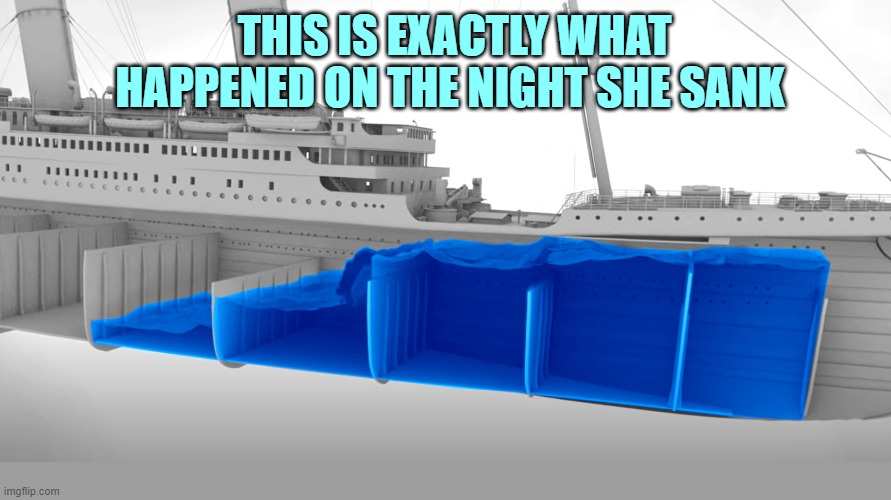
I’m going to talk about what exactly happened that caused Titanic to sink, for those who are less familiar with the wreck. If you don’t want to read over it, I’m not offended.
—
WHAT HAPPENED THAT NIGHT . The RMS Titanic was doing its best to make it to New York from Southampton within three days to make it in “record time.” Bruce Ismay, the owner of the ship and a member of White Starline, basically wanted to make good press by doing this. For this reason, Titanic was traveling through the Atlantic Ocean during the winter season at a top speed of 23 knots (27mph or 44km/hour).
…
Titanic had received many ice warnings from numerous other ships in the area, but fake captain Bruce Ismay was more interested in making good press than valuing human life. This was especially dangerous in the conditions of the Atlantic that night: a flat-calm dark, moonless night.
…
One might think that God wanted the ship to go down considering the outrageously rare conditions of that night.
…
– There was no moon
– Extremely gentle waves
– No swells
– No wind
– No light that illuminated around the perimeter of the iceberg.
Basically, Titanic was sailing at top speed in icy waters in the dark, which was a GENIUS decision.
—
Late into the night of April 11th, 1912, one of the crew spotted an iceberg, “straight ahead.” Unfortunately, the size of the ship meant that they would have needed to be at a distance of half a mile (804.7 meters) from the iceberg to stop in enough time to avoid hitting it. Titanic was 900ft (274m) away from the berg when it was spotted.
—
At this point, she was doomed. Nothing could save her, though the crew didn’t know that yet. First Officer William Murdoch frantically ordered a “hard to port”, or a sharp left to try to avoid colliding into the berg head-on. While they were able to avoid a head-on collision, they still side-swiped the berg at a significant force.
—
The force was enough to cause the iron rivets holding Titanic’s steel plating together to burst open in several places. Scientists found six slits in her hull plating that showed where the water came rushing in. The ocean basically swamped the Titanic, and the design flaw in her watertight compartments caused each compartment to flood over.
—
While the distance between the iceberg and the RMS Titanic meant the ship was doomed no matter what happened, the decision to take a sharp left instead of slamming straight into it probably saved many more lives that night. The Titanic took 2hrs and 40 minutes to sink. I am certain that number would have been much faster had she hit the berg head-on, but we’ll get there in a minute.

For those that understandably didn’t read the whole caption on the previous image, here’s the basic info you need to know to understand why: They spotted the berg too late.
…
The size of the ship meant that Titanic would have needed to be at a distance of half a mile (804.7 meters) from the iceberg to stop in enough time to avoid hitting it. Titanic was 900ft (274m) away from the berg when it was spotted. The only way she could have survived, was a collision above the waterline.
It’s almost impossible to hit an iceberg above the water line.



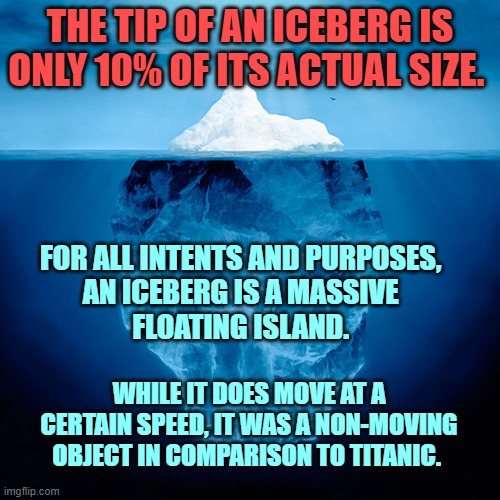

For those who use the metric system, this is roughly 43.45 km/hr, or rounded it to 43.5km/hour.
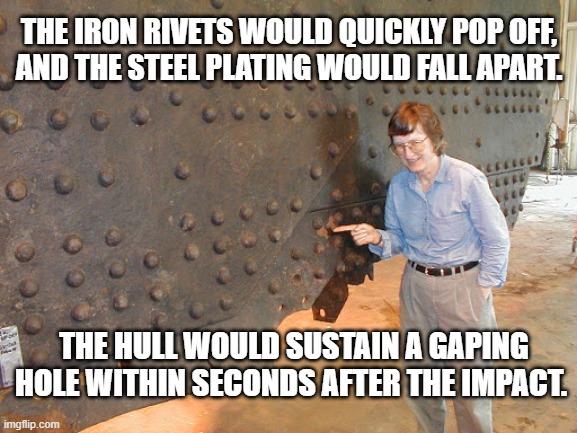
Titanic’s steel plating was held together by wrought iron rivets. In a situation like this, it’s similar to trying to stick two wooden planks together with an Elmer’s glue stick. Iron is weaker than steel, and in the frigid temperatures of that night, it made the metal more brittle.
…
In a head on collision with an iceberg-island, the Titanic’s hull would absorb a significant amount of impact, and the force would be too great for those iron rivets to handle. It only took a side-swipe to tear several slits into the ship. Imagine the larger amount of force, directly tearing into both the steel plating, and the iron rivets. They’d pop right off, and the whole thing would essentially fall apart into the ocean floor.
…
Not to mention such a collision would kill many of the crewmembers on impact. I imagine Officer Murdoch was trying to avoid that as well.
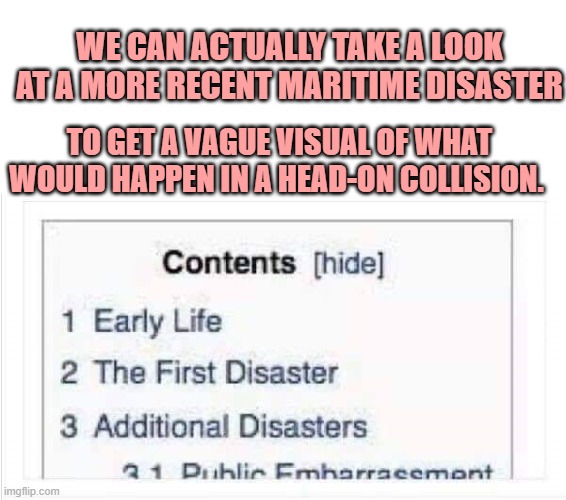

I summarized some details.

That was a shorthand for what happened. It wasn’t just a case where the ship suddenly didn’t have a hull anymore. The S.S. Estonia was a ferry and cargo ship that made regular trips between Tallinn, Estonia, and Stockholm Sweden. On her last trip to Stockholm, she was carrying a larger amount of cars and people than her load capacity could reasonably handle. Six hours into the journey, there was a swell of sorts, that caused the ship to hit the water in a way that tore her visor off. This left a gaping hole in the hull, and the ship swiftly sank into the Baltic Sea. This YouTube video is the best simulation I have found for the disaster, but unfortunately it doesn’t have sound: https://www.youtube.com/watch?v=BpRd7iiVgJM&t=83s&ab_channel=lhs96105
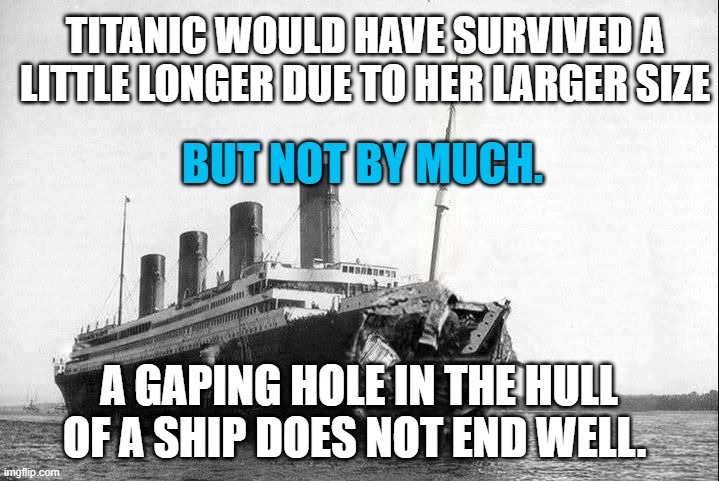
Obviously, the Titanic had different circumstances. I simply used that example because the hull damage was similar to what I **think** the damage to Titanic’s hull in a head-on collision would have been. However, a ship with significant front damage BENEATH the waterline will never not end in some form of sinking. It doesn’t matter whether it’s the hull, or the side
– if it goes beneath the waterline, it will sink the ship.
– The S.S. Estonia (visor came off beneath the waterline)
– The Costa Concordia (struck a rock beneath the waterline)
– The RMS Titanic (struck an iceberg)
– The S.S. Andrea Doria (had a collision with with the SS Stockholm. The Stockholm survived, as the severe damage to the prow was above the waterline)
– The RMS Britannic (struck a water mine)
– The RMS Lusitania could technically count, but it was under attack, so there were more than one factors going on there.
– The MTS Oceanos (this one was interesting, because it only took a single pipe explosion within the watertight compartments to sink the entire ship) . I could keep going, but you get the point. Ships do not survive significant damage beneath the waterline.

I hope you enjoyed reading this as much as I enjoyed making it!
Feel free to add your own thoughts about the Titanic, AS LONG AS THEY DON’T INVOLVE THAT OLYMPIC CONSPIRACY THEORY.
For those that are confused: There’s a conspiracy theory that the Titanic wreck is actually the RMS Olympic, a luxury ocean liner with an extremely similar design that was released a year earlier than Titanic.
The theory says that White Starline switched the ships, and deliberately sank the Olympic to collect insurance money on the Titanic.
This theory makes absolutely no sense. The social, financial, and legal repercussions of a luxury ocean liner sinking on her maiden voyage with a 1,500+ fatality rate has a devastation that greatly outweighs the amount of the insurance payout. Bruce Ismay, the owner of the Titanic, survived the sinking when he hopped onto one of the last lifeboats. He died in disgrace.
Anyway, thanks for reading!
There’s a reason my text layout includes the little dots and extra paragraph breaks. If you’re interested in the reason behind this, I explained it here.